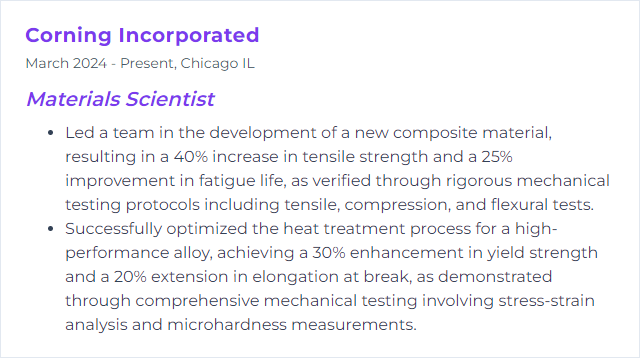Top 12 Materials Scientist Skills to Put on Your Resume
In the competitive field of materials science, showcasing a set of specialized skills on your resume can lift your candidacy from background noise to genuine contender. The list below spotlights the top 12 skills materials scientists should emphasize to stand out and deliver results on day one.
Materials Scientist Skills
- Spectroscopy
- Microscopy
- X-ray Diffraction (XRD)
- Scanning Electron Microscopy (SEM)
- Transmission Electron Microscopy (TEM)
- Thermogravimetric Analysis (TGA)
- Differential Scanning Calorimetry (DSC)
- Atomic Force Microscopy (AFM)
- Chemical Vapor Deposition (CVD)
- Polymer Characterization
- Crystallography
- Mechanical Testing
1. Spectroscopy
Spectroscopy probes how materials interact with electromagnetic radiation, revealing composition, bonding, structure, and even local environments across UV–Vis, IR, Raman, XPS, and more.
Why It's Important
It unlocks chemical identity and structure–property relationships. With it, you verify purity, track reactions, map defects, and guide synthesis—fast and with rigor.
How to Improve Spectroscopy Skills
- Calibrate and maintain instruments for wavelength accuracy, intensity stability, and baseline cleanliness.
- Upgrade detectors and sources to boost sensitivity and selectivity; tighten slits and optics when resolution matters.
- Refine sample prep to cut scattering and noise: consistent thickness, clean substrates, proper concentrations, and low-fluorescence matrices.
- Strengthen data analysis using robust preprocessing, peak fitting, chemometrics, or machine-learning models for complex spectra.
- Go multimodal: pair complementary methods (e.g., Raman + IR, XPS + Auger) to fill information gaps.
Do these well and weak peaks suddenly speak.
How to Display Spectroscopy Skills on Your Resume

2. Microscopy
Microscopy visualizes micro- and nanoscale features—grain boundaries, phases, defects, interfaces—tying structure to performance in a way bulk methods cannot.
Why It's Important
It exposes what governs failure and function: pores, precipitates, crystallite size, surface roughness, interfacial chemistry. See more, guess less.
How to Improve Microscopy Skills
- Push resolution with SEM, TEM, or AFM when optical limits bite; use super-resolution where appropriate.
- Increase contrast via staining, phase contrast, dark-field, or EDS for elemental mapping.
- Nail sample prep: careful cutting, polishing, thinning, and low-damage ion milling preserve truth in the microstructure.
- Process images wisely with noise reduction, deconvolution, and quantitative segmentation for reproducible metrics.
- Stay current on detectors, automation, and correlative workflows to shorten time-to-insight.
Preparation and imaging conditions make or break the result.
How to Display Microscopy Skills on Your Resume
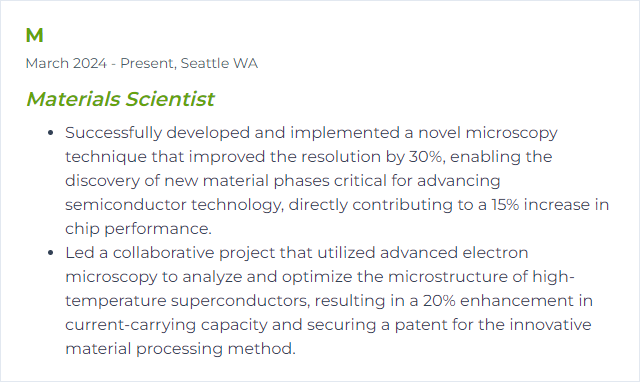
3. X-ray Diffraction (XRD)
XRD determines crystalline structures, phases, lattice parameters, texture, and crystallite size by analyzing the diffraction pattern from a powdered or thin-film sample.
Why It's Important
Phase identification and quantification guide processing windows, performance predictions, and stability assessments. It’s the foundation for crystallography in practice.
How to Improve X-ray Diffraction (XRD) Skills
- Prepare representative samples to minimize preferred orientation; grind uniformly and level the surface.
- Calibrate routinely with standards to maintain 2θ accuracy and instrument profile functions.
- Tune scan parameters (step size, dwell time, range, slit optics, wavelength) to balance resolution and speed.
- Use modern analysis for phase ID, Rietveld refinement, crystallite size/strain, and texture.
- Thin films: apply GIXRD and rocking curves to isolate film signals and probe orientation.
- In situ studies under temperature or pressure to capture phase transitions and kinetics.
- Go advanced with synchrotron beamlines or SAXS/WAXS for nanoscale order and weak scatterers.
Good data in, trustworthy models out.
How to Display X-ray Diffraction (XRD) Skills on Your Resume
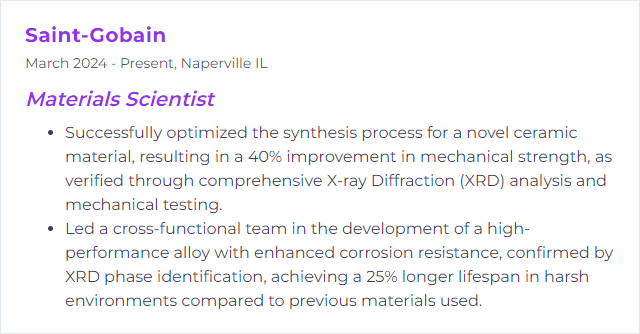
4. Scanning Electron Microscopy (SEM)
SEM scans a focused electron beam across a surface to reveal topography, composition contrast, and microstructural details from submicron to nanoscale.
Why It's Important
It exposes morphology, inclusions, fracture features, coatings, and contamination—often the smoking gun behind performance swings.
How to Improve Scanning Electron Microscopy (SEM) Skills
- Prep smart: clean, mount rigidly, and add a thin conductive coat for nonconductors to avoid charging.
- Match voltage and working distance to the task; lower kV for surface detail, higher kV for penetration and EDS.
- Choose the right detector: secondary for topography, backscatter for Z-contrast; pair with EDS for elemental maps.
- Stabilize the environment (vibration, temperature, contamination) to hold resolution steady.
- Post-process images for contrast, noise, and quantitative measurements with documented workflows.
Small tweaks, big clarity.
How to Display Scanning Electron Microscopy (SEM) Skills on Your Resume
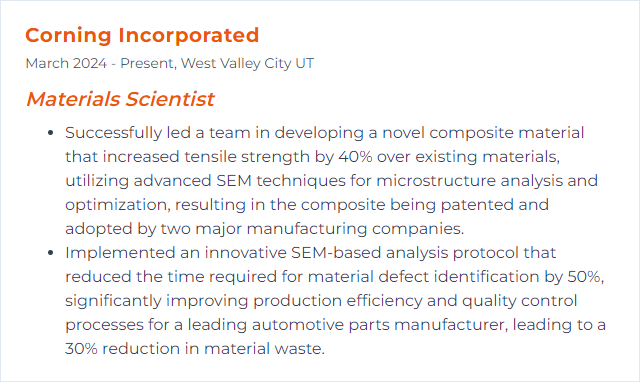
5. Transmission Electron Microscopy (TEM)
TEM sends electrons through ultra-thin specimens to resolve atomic-scale structure, chemistry, and defects via imaging and diffraction.
Why It's Important
It reveals dislocations, interfaces, grain boundaries, precipitates, and nanoscale phases—the scaffolding behind material behavior.
How to Improve Transmission Electron Microscopy (TEM) Skills
- Perfect sample prep with low-damage thinning and precise site selection; FIB workflows help for cross-sections.
- Optimize accelerating voltage and aberration correction to balance resolution with beam damage.
- Adopt direct electron detectors and fast cameras to improve SNR and capture dynamics.
- Process data with rigorous drift correction, denoising, and quantitative diffraction analysis.
- Go in situ for heating, biasing, or straining to watch transformations unfold.
- 3D insight via electron tomography when morphology or porosity matters.
- Keep learning through advanced courses and user groups; TEM evolves quickly.
Control the beam, control the truth you see.
How to Display Transmission Electron Microscopy (TEM) Skills on Your Resume
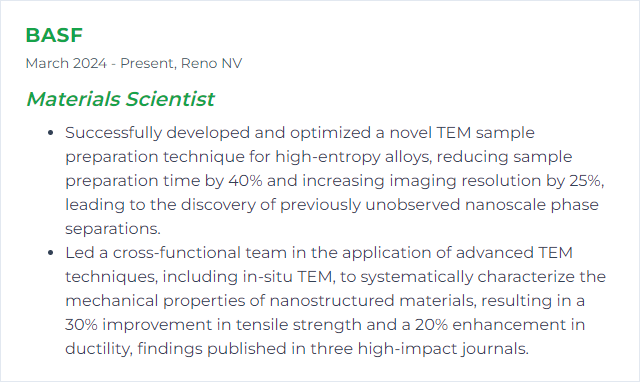
6. Thermogravimetric Analysis (TGA)
TGA tracks mass change with temperature or time under controlled atmospheres, exposing decomposition steps, oxidation, moisture, fillers, and residuals.
Why It's Important
Thermal stability, composition, and degradation pathways underpin processing choices and lifetime predictions. TGA turns that into numbers.
How to Improve Thermogravimetric Analysis (TGA) Skills
- Right sample mass (typically a few milligrams) and uniform loading to avoid thermal gradients.
- Regular calibration and buoyancy/baseline corrections to tame drift.
- Tight atmosphere control with suitable purge gases and flow rates to steer reaction pathways.
- Optimize heating rates: slower for resolution, faster for throughput; match to kinetics goals.
- Deconvolve events and perform kinetic analysis to separate overlapping steps.
- Cross-check with DSC, FTIR of off-gases, or XRD of residues for full context.
Clean baselines, clean conclusions.
How to Display Thermogravimetric Analysis (TGA) Skills on Your Resume
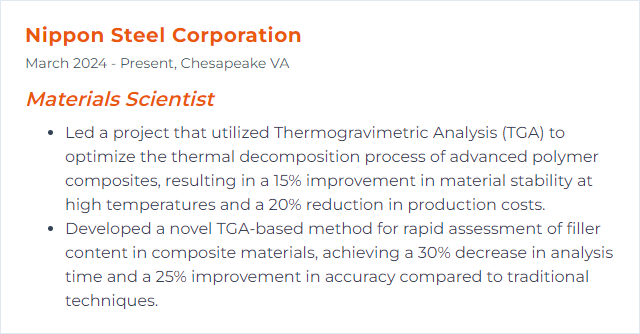
7. Differential Scanning Calorimetry (DSC)
DSC measures heat flow associated with transitions—glass transition, crystallization, melting, curing—revealing thermal behavior and purity.
Why It's Important
Processing windows, crystallinity, cure state, and stability all ride on these transitions. DSC gives precise, decision-ready data.
How to Improve Differential Scanning Calorimetry (DSC) Skills
- Calibrate frequently for temperature and enthalpy using reliable standards.
- Standardize sample prep for mass, geometry, pan type, and sealing to reduce variability.
- Use appropriate purge gases and flow rates to curb unwanted reactions and improve baseline stability.
- Apply baseline corrections and empty-pan runs to control drift.
- Tune scan rates to balance transition resolution and sensitivity; modulated DSC when transitions overlap.
- Analyze rigorously with proper onset, peak, and integration methods; report uncertainties.
- Maintain the instrument—clean furnaces, healthy sensors, and reliable cooling mean consistent results.
Detail-first methods pay off in reproducibility.
How to Display Differential Scanning Calorimetry (DSC) Skills on Your Resume

8. Atomic Force Microscopy (AFM)
AFM scans a sharp tip over surfaces to map topography and nanoscale properties—roughness, stiffness, adhesion—with sub-nanometer sensitivity.
Why It's Important
When surface drives performance—tribology, coatings, electronics, biomaterials—AFM delivers ground-truth detail.
How to Improve Atomic Force Microscopy (AFM) Skills
- Choose the right probe: high-aspect-ratio or ultra-sharp tips for steep features and high resolution.
- Use gentle imaging modes like tapping or PeakForce to preserve delicate samples.
- Control environment (vibration, humidity, temperature) and consider liquid cells when native conditions matter.
- Quantify mechanics via force spectroscopy and nano-mechanical mapping with well-characterized tip calibrations.
- Correlate techniques by pairing AFM with Raman or fluorescence for structure–function linkage.
- Process data carefully with flattening, line-by-line correction, and validated roughness/modulus metrics.
Surface science without guesswork.
How to Display Atomic Force Microscopy (AFM) Skills on Your Resume
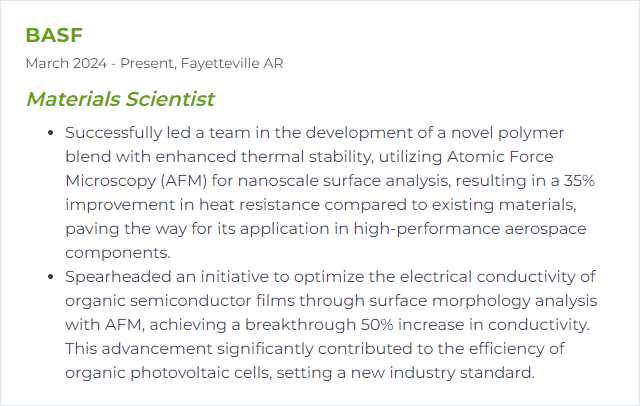
9. Chemical Vapor Deposition (CVD)
CVD grows thin films and coatings from vapor-phase precursors onto heated substrates, enabling high-purity, conformal layers with precise thickness control.
Why It's Important
It underpins electronics, optics, energy, and barrier coatings where uniformity, stoichiometry, and defect density decide performance.
How to Improve Chemical Vapor Deposition (CVD) Skills
- Pick suitable precursors with clean decomposition paths and matched vapor pressures.
- Dial in temperature profiles across the reactor to stabilize nucleation and growth kinetics.
- Control pressure and flow for uniform mass transport; model residence times and boundary layers.
- Prepare substrates with rigorous cleaning and surface activation to boost adhesion and nucleation density.
- Monitor in situ using optical or spectroscopic signals to adjust on the fly and reduce waste.
Process discipline equals film quality.
How to Display Chemical Vapor Deposition (CVD) Skills on Your Resume

10. Polymer Characterization
Polymer characterization maps structure to properties through spectroscopy, chromatography, thermal analysis, rheology, and microscopy to understand molecular weight, composition, morphology, and transitions.
Why It's Important
Designing, processing, and qualifying polymer systems requires clarity on chain architecture, crystallinity, additives, and aging. No clarity, no control.
How to Improve Polymer Characterization Skills
- Deepen spectroscopic insight with FTIR and NMR to pin down functional groups and sequence distribution.
- Measure distributions via SEC/GPC and HPLC for molecular weight and compositional detail.
- Strengthen thermal profiling using DSC and TGA to quantify Tg, Tm, crystallinity, and stability.
- Visualize morphology with SEM/TEM and AFM to connect spherulites, phase separation, or fillers to performance.
- Master rheology—steady, oscillatory, and temperature sweeps—to decode viscoelastic behavior and processing windows.
- Use multi-technique correlation so results converge on the same story rather than isolated snapshots.
- Document conditioning (humidity, temperature, aging) to keep comparisons fair and reproducible.
Polymers are storytellers; use the right tools to hear them clearly.
How to Display Polymer Characterization Skills on Your Resume
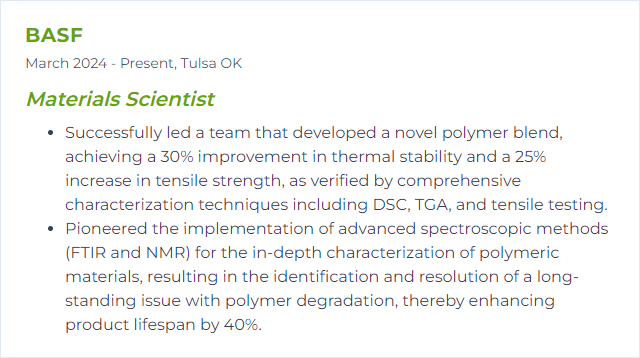
11. Crystallography
Crystallography deciphers atomic arrangements and symmetry in solids, explaining anisotropy, defect energetics, and phase stability.
Why It's Important
Structure governs properties. With crystal information in hand, you can engineer band gaps, diffusion paths, slip systems, and more.
How to Improve Crystallography Skills
- Rebuild fundamentals in symmetry operations, reciprocal space, and diffraction selection rules.
- Practice with real data from powder and single-crystal measurements; iterate indexing and refinement.
- Get fluent in software for structure visualization, refinement, and texture analysis.
- Explore electron diffraction and 3D techniques when crystals are tiny or twinned.
- Cross-validate with complementary methods (XRD, TEM, neutron diffraction) to reduce ambiguity.
Precision here cascades into better models everywhere else.
How to Display Crystallography Skills on Your Resume
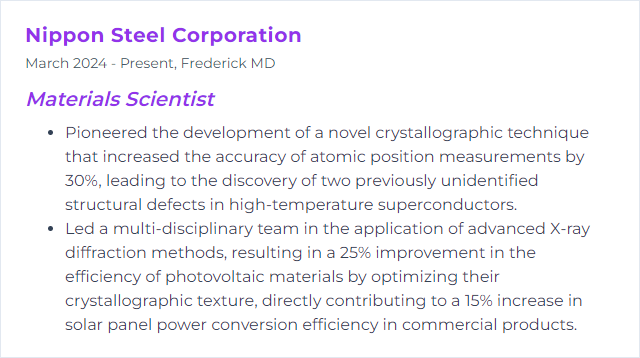
12. Mechanical Testing
Mechanical testing quantifies strength, stiffness, ductility, toughness, hardness, fatigue, and fracture behavior under controlled loading and environments.
Why It's Important
Design lives or dies on real stress–strain data. These tests inform safety margins, qualification, and failure analysis.
How to Improve Mechanical Testing Skills
- Follow recognized standards (e.g., ASTM, ISO) to ensure comparability and credibility.
- Calibrate systems and fixtures regularly; verify load cells, extensometers, and alignment.
- Prepare specimens consistently with tight control on geometry, surface finish, and machining direction.
- Control environment—temperature, humidity, and strain rate—to reflect service conditions.
- Adopt advanced methods like digital image correlation for full-field strain and high-rate testing for impact scenarios.
- Analyze thoroughly with clear failure criteria, uncertainty estimates, and microstructural correlation.
- Report transparently: methods, equipment, calibration, raw curves, and derived metrics.
Better tests, better decisions, fewer surprises.
How to Display Mechanical Testing Skills on Your Resume
